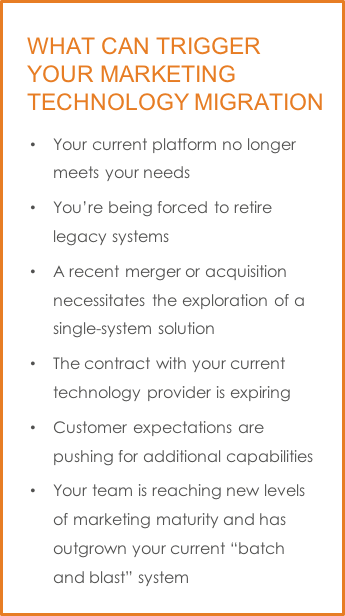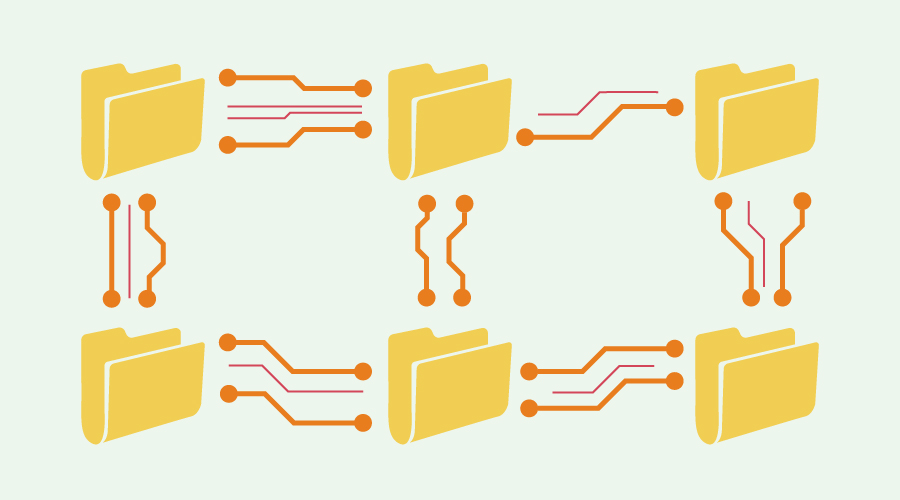Like what you see?
4 Tips For Your Marketing Automation Migration
 As marketing continues to mature and technology options become vast, it’s almost inevitable that a technology change, shift or migration will need to happen at some point. We’ve seen first-hand that many companies are starting to transition to a new marketing automation platform. And this can be triggered by many things.
As marketing continues to mature and technology options become vast, it’s almost inevitable that a technology change, shift or migration will need to happen at some point. We’ve seen first-hand that many companies are starting to transition to a new marketing automation platform. And this can be triggered by many things.
But at the end of the day, marketers are starting to find ways to put strategy before technology. Larger B2B companies are seeing the need to shift to bigger, broader platforms, while smaller B2B companies are looking for user-friendly solutions that are simpler to manage. Regardless of your situation, we’ve learned a few lessons along the way that we want to share.
1. A Successful Migration Takes Time … and a Timeline
The decision to migrate your marketing automation platform requires some careful planning and consideration, starting with a thorough analysis of the two systems. This analysis should include capabilities, cost to make all the necessary connections (both time and money) and training and additional resources needed to implement a sustainable solution. Look at what’s working, what’s not and what needs to be working differently.
Engage your IT team, leadership and other key stakeholders to align on technical, business and customer requirements. Make sure you understand system dependencies — what other things need to be considered or could be impacted? The goal is to make sure that time and resources are allocated to build a foundational infrastructure that will support the long-term strategy.
And that takes time. Establish critical milestones along the way that will help you stay on track. Depending on the complexity of the move, it could likely take a full year or two to make the shift. Knowing that in the beginning can help alleviate the risk of failing to effectively make the switch in a reasonable timeframe, thereby continuing to pay for the maintenance of both systems.
2. Don’t Overlook the Need for Training or Additional Resources
For example, we have experience migrating from a legacy marketing automation platform to the industry leader Salesforce. And we’ll tell you, Salesforce Marketing Cloud (SFMC) requires a new set of skills to manage and execute in the system. When making the switch, internal teams (including IT, marketing and sales) and agency partners who will be working in the system will need to be trained. These costs — both in time and money — should be considered and accounted for in this early analysis.
The Salesforce suite of solutions is powerful and unlocks infinite possibilities for an organization, provided that you understand what they are and how to use them. Regardless of the platform itself, it’s important to have a strategy before implementing technology. A well-thought-out strategy creates a roadmap that guides the consideration of “add-on” technologies, creating and prioritizing use cases around each one so that they don’t get lost or go unused.
3. Make Room for Everyone at the Table
You might think migrating your marketing automation platform is a job solely for your IT team, or maybe you think that IT doesn’t need to be involved at all. Either way, we’ve found that the most successful migrations include a cross-functional team where IT, marketing and sales come together to ensure that critical perspectives are not lost.
When the technology change is driven only by IT, the business perspective may not be accurately captured. And the reverse is also true — business requirements may not be taking into account the technical updates needed to implement. In both cases, agendas slanted too far in one direction (technical or business) will create some level of rework, and that will cost you valuable time and, in most cases, money.
Let’s go back to transitioning to Salesforce as an example. Because SFMC and Salesforce CRM (Sales Cloud) are structured differently than other marketing automation platforms, IT teams may want to be even more involved than they’ve historically been with other marketing program implementations. We can tell you first-hand, working in SFMC requires more development time with skills in SQL and Amp Script required to execute great campaigns.
Salesforce aside, we’ve found that active participation from all teams who will interact with the new platform is important to a successful implementation. Making sure the owners of the business, customers and technical stakeholders have a voice early in the process helps to ensure that the needed infrastructure is in place. This includes both current and future states of the platform, system and data access, and building in a way that will accommodate future growth plans.
4. Someone Needs to Speak Everyone’s Language
Working to align technical, marketing and business requirements requires someone who understands all the areas in order to help facilitate the most productive conversations. If no one within your organization can play that role, it’s beneficial to hire a third-party “translator.”
Simantel has served in this role as a facilitator for many of our clients. Sometimes this means sitting between teams from across the enterprise explaining marketing requirements to technical teams, and vice versa. Other times it means sitting with the organization and the technology implementer or technology product owner to help connect the dots between what the business needs and what the technology can do, ultimately marrying both in the most successful way possible.
This is as much about strategy as it is the technical requirements and implementation. Improved success comes when the strategy for creating effective and efficient ways to reach and engage your end user is well-defined and understood by all your stakeholders.
A transition is an ideal time to reassess current state strategies to ensure legacy (outdated) approaches are not migrated and the new infrastructure supports where the business wants to go next. Again, outside perspective can be beneficial as an objective third-party can help to facilitate productive conversations around the needs of all parties, resulting in a strategy that addresses business, technical and customer requirements.
Now What?
Whether you’re migrating your marketing automation platform because you want to or you need to, the task is no less daunting. Creating a plan that outlines the necessary steps and engages all the right people can help you successfully navigate a solution that will meet your evolving marketing needs.
Need Help Getting Started?
We’ve created an alignment worksheet to help you document what’s important and move your organization toward an aligned strategy.



